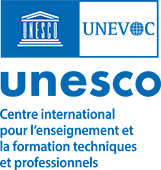
Le Centre International UNESCO-UNEVOC: Qui nous sommes | Ce que nous faisons | Nous rejoindre | Nous contacter
Le Réseau UNEVOC: En savoir plus sur le Réseau | Répertoire du Réseau UNEVOC
Espace Membres: Tableau de bord du Centre UNEVOC
Domaines thématiques: Inclusion et jeunes | Innovation et avenir de l'EFTP | Engagement du secteur privé | Les ODD et l'écologisation de l'EFTP
Nos programmes et projets clés: BILT: Connecter innovation et apprentissage | Renforcer la résilience de l’EFTP | Programme pour le leadership en EFTP | Journée mondiale des compétences des jeunes
Activités passées: Réponse COVID-19 | i-hubs: Former des pôles d'innovation | Forums mondiaux de l'EFTP | Conférences virtuelles | YEM Portail de connaissances
Nos services et ressources: Publications | Forum TVET | Profils nationaux d'EFTP | Glossaire TVETipedia | Pratiques prometteuses | Toolkits for TVET Providers | Formation à l’entrepreneuriat
Journal et événements: Grandes Manifestations EFTP | Journal UNEVOC
Also known as e-learning or online learning, it is a form of education in which teachers and students are physically separated. Various technologies such as Skype allow for teachers and students to interact and communicate. Traditional distance learning focused on individuals in remote areas and it used to be via mail.
The learner has been matched with a teacher, tutor, or volunteer with whom he/she has regular interaction with regard to the content of the distance learning curriculum, and who provides support throughout the distance learning experience. Distance learning is characterized by all of the following:
Education and training imparted at a distance through communication media: books, radio, TV, telephone, correspondence, computer or video.
 Source:
Source: National Research and Development Centre for adult literacy and numeracy (commissioned by the EU), European Adult Learning Glossary level 1, 2011
National Research and Development Centre for adult literacy and numeracy (commissioned by the EU), European Adult Learning Glossary level 1, 2011
Instructional model in which the teacher or trainer and the learner are physically separated and use various resources and technologies to interact, simultaneously or not.
Comment
Distance learning may combine e-learning, online learning, virtual learning, books, audio, video and correspondence courses;
 Source:
Source: Cedefop, Glossary. Terminology of European education and training policy, (accessed 03/2023)
Cedefop, Glossary. Terminology of European education and training policy, (accessed 03/2023)
Pour en savoir plus et contribuer